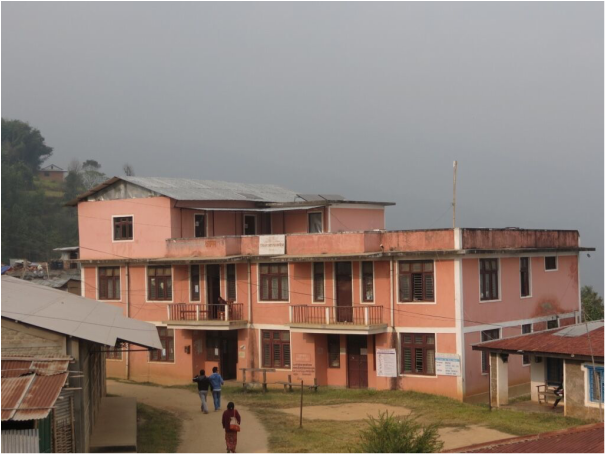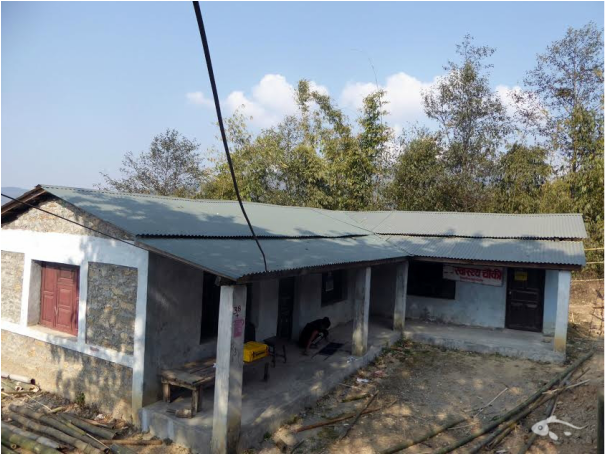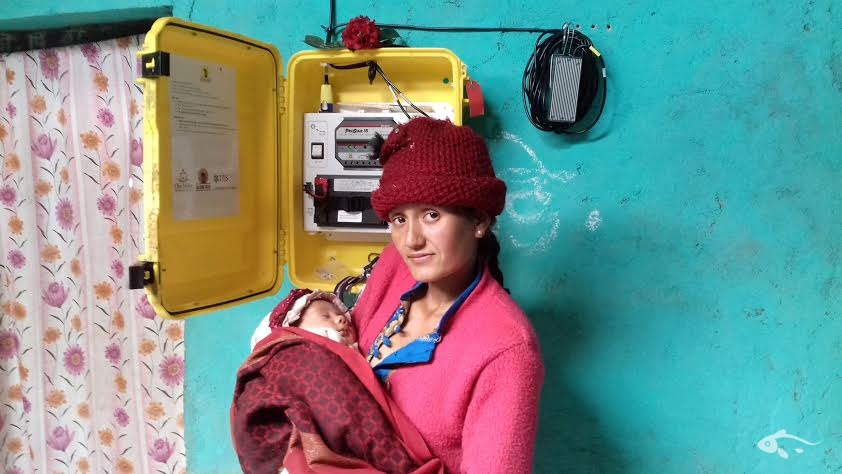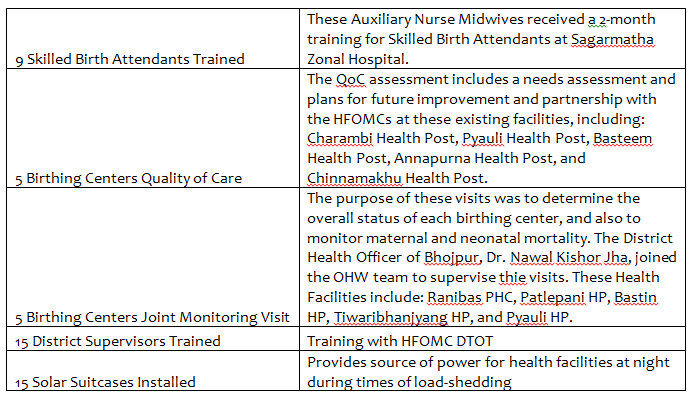January – April, 2016BackgroundBhojpur is a hill district located in the northeastern part of Nepal. It is home to 172,098 people, and reports 4,474 pregnancies per year. In 2014, One Heart World-Wide started the needs assessment process for this district, but due to the earthquakes that destroyed parts of Nepal in 2015, we had to pause our initial program activities and focus on districts such as Dhading and Sindhupalchok, where over 90% of the health facilities sustained either full or partial damage. In late 2015, we started up our program activities in Bhojpur again, and in 2016, we have started rolling out the second phase of our Network of Safety – Program Implementation. Over the next three years, we will train community outreach providers, implement a community outreach program, upgrade health facilities into birthing centers, and train Skilled Birth Attendants. We will also develop a basic health infrastructure, provide health education, and foster community empowerment in collaboration with the local District Health Department. Our goal for the next five years is to double the rate of deliveries with a Skilled Birth Attendant, and reduce the maternal and neonatal mortality by at least 50%. Project ActivitiesSolar Suitcase Installation: Nepal heavily depends on hydropower, and rivers dry out during the winter. This results in huge electricity outages up to 18 hours a day during the winters and dry season of the year. For the birthing centers that are located in the more remote areas of Nepal, the sporadic electricity compromises the ability of the skilled birth attendants to provide safe delivery services during the nighttime, and increases the risk of complications during delivery. In order to fulfill the power needs of the rural birthing centers, we have currently installed 15 solar suitcases in birthing centers around Bhojpur. These suitcases not only provide essential lighting for the delivery and waiting rooms, they also contain a fetal Doppler, mobile chargers and two sets of rechargeable headlamps. Needs assessment to expand new birthing centers: Many women don’t receive emergency care immediately as needed because of three delays:
Quality of Care (QoC) Assessment of Birthing Centers: The quality of care received by mothers and babies in remote areas is often reported as poor. Poor sanitation and bad hygienic practices can lead the infection to the mother and newborns. Infection is one of the major causes of maternal and newborn death globally and locally. Quality care assessment is one of the routine activities completed so that all women and newborns can receive clean and dignified care during the delivery. SBA Training: Pregnancy is a natural process for which medical assistance is not considered as a need or requirement in Nepal. As a result, many Nepalese women, especially those residing in more rural areas of Nepal, deliver at home. In most communities, traditional birth attendants are usually primary service providers who have never received modern training in midwifery. The lack of training poses a risk to the lives of the women and newborn. Currently, there are only a few SBAs that serve about 45,000 women per year in Bhojpur. One Heart World-Wide has identified several eligible nurses that are on their way to becoming certified skilled birth attendants. Post-training, they will be able to provide the maternity care necessary to conduct safe deliveries in this district. 2015
2016
DataUpcoming Plans
Challenges
Results2016 Quarterly GoalsCase Story: Tulasha Khanal, Auxiliary Nurse MidwifeStory transcribed by: Suraj Shah, OHW Photos by: Suraj Shah, OHW Edited by: Alisha Giri Location: Dhading, Nepal One Heart World-Wide came into this rural area, installed a solar suitcase and also gave us training. This is something very big hearted from One Heart. Thank you many times to We Care Solar and One Heart World-Wide for such a novel work to save pregnant women and newborn babies' lives. Blessings from a mother’s heart and soul that will always follow you and brighten your path. Namaste! (Hello!) My name is Tulasha Khanal. I am 35 years old and have been working as an Auxiliary Nurse Midwife since 1999. I am currently working here at the local Birthing Center. I am living with my in-laws, husband, and my only son, who is currently in school. My husband also works as a senior assistant health worker. I always wanted to work in this field growing up, and it has become my passion. I have the full support of my family as well as my husband. Three years ago I received Skilled Birth Attendant (SBA) training and since then, I’ve been working as an SBA/Auxillary Nurse Midwife. Currently, we are facing the problem of lighting for deliveries that take place at night. Currently 90% of the deliveries we do at this center are at night. We don’t have a reliable option for a steady power source and sometimes have to resort to using a simple hand torch or even our mobile phones for night deliveries. We also have 13-19 hours of load-shedding every day in this area. (Load-shedding is the deliberate shutting down of power by the government to bypass shortage of electricity). For surgical procedures such as an episiotomy, I will sometimes have to ask individuals accompanying the patient to hold the torch for me while I perform the surgery. While we are used to these procedures, it can be frightening and nerve-racking for these individuals and the patients themselves. They tend to get nervous and start shaking so that the light source they are holding is not steady, which forces me to perform partially in the dark. This exponentially increases the already high risk of complications, especially during serious procedures. The responsibility of saving the mother and newborn baby’s lives in these conditions is a heavy responsibility and poses a serious issue that we face in these rural birthing centers. Just this past month we had a case with a pregnant woman named Gauri Lama. She came in during the day and I used my judgment and past experiences to conclude that she would deliver her baby before 6PM. Six PM came and went and she was still there, unable to push, with no sign of delivery. By 9PM she was still here and still no signs of delivery, although there had already been a Meconium stain. I started to do all the procedures that I’d learned through my training and realized that the baby had already inhaled the Meconium. I had asked one of the sisters to help hold a light for me, and by this time, the torchlight was already at low power. With a lot of difficulty, I started the emergency procedure, and with much difficulty, I was able to successfully take the baby out and immediately start resuscitation. During this, the torchlight died and we were forced to start using our mobile phones for lighting. This is just an example of one of the many cases that I’ve had to perform with very limited lighting. Tonight also I have pregnant women who are ready to delivery, but I'm very happy and much more confident because now we have new solar power inside our delivery room. This light was really very important for us. Now I can do my job in the best way without proper lighting. Today I feel like a kid at a candy store. Having these solar lights will make our work so much easier and save more lives. The two beautiful bright lights will not only brighten this one room but because of the long cord, we can use them to light rooms and passages, and charge devices such as the Fetal Doppler. In an emergency, it’s difficult to put a Fetoscope in to listen for the baby’s heartbeat. Now, we will be able to allow the pregnant mother and her family members to listen to the fetal heartbeat and I can instruct my assistant to listen as well. We also got two new headlamps so now I don’t have to rely on untrained individuals to hold up a light. I can focus a steady light on exactly what I need to successfully complete any procedure. The multi-mobile charger we received also makes a huge difference when working at night, as I often tend to run out of charge on my phone since I use it to make frequent calls to prepare ambulances, inform my colleagues, or request help. I’ve had situations where my phone dies right in the middle of a conversation like the ones mentioned above, and there is no power to charge it back. Even just a few minutes of delays due to lack of power can have a huge impact. 2016 Quarter 1 Report, PDFComments are closed.
|
TFISH FUND BLOGWe update news and reports directly from the field written by our NGO partners daily. Top PostsPHOTOS & VIDEOSIN THE NEWSCategories
All
Archives
August 2017
|
|
© Copyright 2011. All rights reserved.
171 Main St. #658 , Los Altos, CA 94022 | [email protected] | 501(c)(3) Tax ID: 45-2885139 |













 RSS Feed
RSS Feed